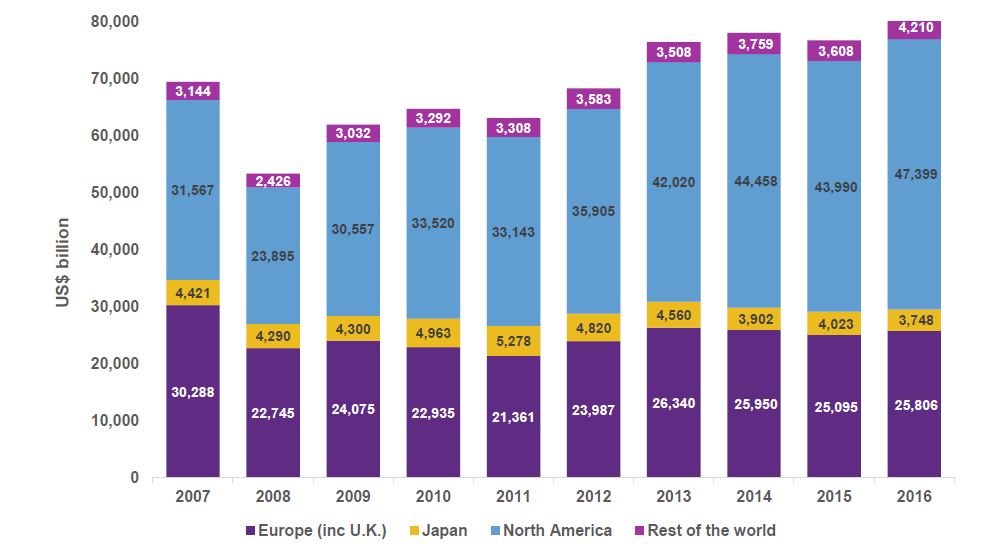Total assets under management (AuM) of the world’s largest 500 managers grew to US$ 81.2 trillion in 2016, representing a rise of 5.8% on the previous year, according to latest figures from Willis Towers Watson’s Global 500 research.
 Looking at the Australian players in the global list, Macquarie Group was in 52nd place with assets of US$362,511m, Colonial State was at 102 with US$147,154m, AMP Capital was at 120 with US$119,476m, BT Investment at 182 with US$60,699 and QIC at 193 with US$57,455m.
Looking at the Australian players in the global list, Macquarie Group was in 52nd place with assets of US$362,511m, Colonial State was at 102 with US$147,154m, AMP Capital was at 120 with US$119,476m, BT Investment at 182 with US$60,699 and QIC at 193 with US$57,455m.
The research, which takes into account data up to the end of 2016, found that AuM for North American managers increased by 7.7% over the period and now stand at US$ 47.4 trillion, whilst assets managed by European managers, including the UK, increased by 2.8% to US$ 25.8 trillion. However, UK-based firms saw AuM decline for the second consecutive year, falling by 4.5% in 2016 to US$ 6.3 trillion.
Although the majority of total assets1 (78.4%) are still managed actively, its share has declined from 79.7% from end of last year as passive management continues to make inroads.
Luba Nikulina, global head of manager research at Willis Towers Watson, said: “It is encouraging to see a return to growth in total global assets, suggesting that managers are finding success in attracting investors towards innovative solutions to achieve superior risk-adjusted returns. Whilst passive assets remain significantly smaller than actively managed assets, the proportion of passively managed assets has grown from 16.5% to 21.6% over the last five years alone. We expect that this trend will continue to put downward pressure on traditional fee structures, particularly amongst active managers seeking to remain competitive and to maximise value to investors.”
The 20 largest asset managers experienced a 6.7% increase in AuM, which now stands at US$ 34.3 trillion, compared to US$ 26.0 trillion ten years ago and US$ 20.5 trillion in 2008. The share of total assets managed by this group of 20 largest managers increased for the third year in a row, rising from 41.9% in 2015 to 42.3% by the end of 2016. Despite this, the bottom 250 managers experienced a superior growth rate in assets managed, rising by 7.3% over the year.
As with previous years, equity and fixed income assets have continued to dominate, with a 78.7% share of total assets1 (44.3% equity, 34.4% fixed income), experiencing an increase of 3% combined during 2016. Continuing from the strong growth they experienced in 2015, assets1 in alternatives saw a 5.1% increase by the end of 2016, closely followed by equities at 4.1%.
Luba Nikulina said: “Alternatives continue to grow in popularity, with investors remaining under pressure to find effective means of diversification in an environment of lower expected returns from traditional asset classes. These strategies often come with greater complexity and require superior risk management. We see this as linked to the growth in assets managed by managers in the bottom half of our list, suggesting that investors favour smaller investment houses with specialist investment skills.”
“Our research has also highlighted awareness in sustainable investing, with 78% of the firms surveyed acknowledging a growing interest from their clients for these sorts of strategies as they continue to look for ways to add value for clients,” said Luba Nikulina.
Whilst BlackRock retains its position at the top of the manager rankings for the eighth consecutive year, further insight shows the main gainers, by rank, in the top 50 during the past five years include, Dimensional Fund Advisors (+31 [76 to 45]), Affiliated Managers Group (+20 [52 to 32]), Nuveen (+16 [36 to 20]), New York Life Investments (+15 [55 to 40]) and Schroder Investment Management, (+15 [59 to 44]).
The world’s largest money managers
Ranked by total assets under management, in U.S. millions, as of Dec. 31, 2016
| Rank | Manager | Country | Total assets |
|---|---|---|---|
| 1 | BlackRock | U.S. | $5,147,852 |
| 2 | Vanguard Group | U.S. | $3,965,018 |
| 3 | State Street Global | U.S. | $2,468,456 |
| 4 | Fidelity Investments | U.S. | $2,130,798 |
| 5 | Allianz Group | Germany | $1,971,211 |
| 6 | J.P. Morgan Chase | U.S. | $1,770,867 |
| 7 | Bank of New York Mellon | U.S. | $1,647,990 |
| 8 | AXA Group | France | $1,505,537 |
| 9 | Capital Group | U.S. | $1,478,523 |
| 10 | Goldman Sachs Group | U.S. | $1,379,000 |
| 11 | Prudential Financial | U.S. | $1,263,765 |
| 12 | BNP Paribas | France | $1,215,482 |
| 13 | UBS | Switzerland | $1,208,275 |
| 14 | Deutsche Bank | Germany | $1,190,523 |
| 15 | Amundi | France | $1,141,000 |
| 16 | Legal & General Group | U.K. | $1,099,919 |
| 17 | Wellington Mgmt. | U.S. | $979,210 |
| 18 | Northern Trust Asset Mgmt. | U.S. | $942,452 |
| 19 | Wells Fargo | U.S. | $936,900 |
| 20 | Nuveen | U.S. | $881,748 |
Source: P&I/Willis Towers Watson World 500

One thought on “Assets of world’s largest fund managers passes US$80 trillion for the first time”